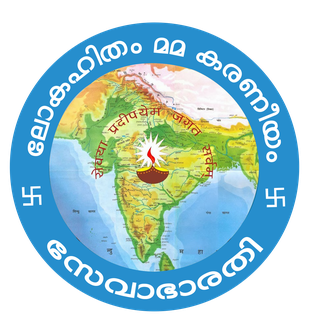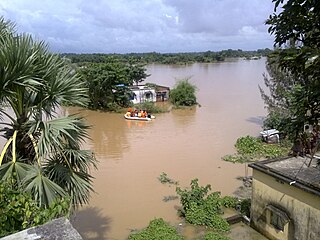
Sri Lanka was one of the countries struck by the tsunami resulting from the Indian Ocean earthquake on December 26, 2004. On January 3, 2005, Sri Lankan authorities reported 30,000+ confirmed deaths.

Kerala is situated between the Lakshadweep Sea to the west and the Western Ghats to the east. Kerala's coast runs some 590 km in length, while the state itself varies between 35–120 km in width. Geologically, pre-Cambrian and Pleistocene formations comprise the bulk of Kerala's terrain. The topography consists of a hot and wet coastal plain gradually rising in elevation to the high hills and mountains of the Western Ghats. Kerala lies between northern latitude of 8°.17'.30" N and 12°. 47'.40" N and east longitudes 74°.27'.47" E and 77°.37'.12" E. Kerala's climate is mainly wet and maritime tropical, heavily influenced by the seasonal heavy rains brought up by the monsoon Weather.

Chengannur is a municipality in the Alappuzha district of Kerala, India. It is located 37 km (23.0 mi) south of the district headquarters in Alappuzha and about 98 km (60.9 mi) north of the state capital Thiruvananthapuram. As per the 2011 Indian census, Chengannur has a population of 23,466 people, and a population density of 1,607/km2 (4,160/sq mi).

Rashtriya Seva Bharati is a non-governmental organization (NGO) that works with economically weaker sections of Indian societies, including tribal.

The 2009 India floods affected various states of India in July 2009, killing at least 36 people in Orissa and 13 in Kerala. The most affected states were Karnataka, Orissa, Kerala, Gujarat and North-East Indian states.

The National Disaster Response Force (NDRF) is an Indian specialised force constituted under the Disaster Management Act, 2005.
Operation Sea Waves was a disaster relief operation undertaken by the Indian Armed Forces in the aftermath of the 2004 Indian Ocean tsunami. Sea Waves was focused on rescue and relief efforts on the Andaman and Nicobar Islands.

Operation Madad was a non-combative and assistance military operation commenced and executed by Pakistan Navy after the massive national floods hit the country. Its primary operations were to conduct SAR raids to support affected areas of Pakistan following the 2010 Pakistan floods. Madadwas the major and the largest naval operation commenced by the Pakistan Navy since the 1971 Naval conflict.

Operation Surya Hope was the Indian Army’s Central Command response to the June 2013 North India floods in Uttarakhand.

In the wake of heavy monsoon rain and flash floods in Jammu and Kashmir, the Indian Armed Forces were deployed in increasing numbers starting 2 September 2014 to conduct search, rescue, relief, relocation, humanitarian assistance and rehabilitation missions in Jammu and Kashmir. By 18 September, over 298,514 people were rescued from the various parts of Jammu and Kashmir by the Armed forces. The Jammu and Kashmir floods, the worst in a century according to Omar Abdullah, the Chief Minister of Jammu and Kashmir, paralyzed the state government. Omar Abdullah, responding to public criticism, told the media "I had no government" in the first few days following the floods, as "My secretariat, the police headquarters, the control room, fire services, hospitals, all the infrastructure was underwater." Adding "I had no cell phone and no connectivity. I am now starting to track down ministers and officers." The Jammu and Kashmir floods of 2014 have been blamed on heavy rainfall, about 8 inches (200mm) on 4 September alone, on climate change, unplanned and uncontrolled development, encroachment of river banks, lakes, ponds, and massive loss of wet lands, absence of local government flood forecasting system, and poor governance. The Armed Forces humanitarian assistance mission in response to the floods was named Mission Sahayata (assistances). Northern Command's humanitarian assistance to Civil authorities was named 'Operation Megh Rahat'. The Indian Army, Air Force, and the Navy, committed large resources to the assistance mission including over 30,000 troops, 15 engineer task forces, 84 Indian Air Force and Army Aviation Corps fixed wing transport aircraft and helicopters, naval commandos and rescue specialists, and Base Hospital, four field hospitals, over 106 medical detachments. "Operation Megh Rahat", ended on 19 September 2014, but "Operation Sadbhavna", the relief and medical assistance support, according to government press release, will continue in "close synergy with the civil administration and the police".
This is a list of notable recorded floods that have occurred in India. Floods are the most common natural disaster in India. The heaviest southwest, the Brahmaputra, and other rivers to distend their banks, often flooding surrounding areas.

The 2015 South India floods resulted from heavy rainfall generated by the annual northeast monsoon in November–December 2015. They affected the Coromandel Coast region of the South Indian states of Tamil Nadu and Andhra Pradesh. More than 500 people were killed and over 1.8 million people were displaced. With estimates of damages and losses ranging from nearly ₹200 billion (US$2 billion) to over ₹1 trillion (US$12 billion), the floods were the costliest to have occurred in 2015, and were among the costliest natural disasters of the year.
The 2017 Sri Lanka floods resulted from a heavy southwest monsoon, beginning around 18 to 19 May 2017. Flooding was worsened by the arrival of the precursor system to Cyclone Mora, causing flooding and landslides throughout Sri Lanka during the final week of May 2017. The floods affected 15 districts, killed at least 208 people and left a further 78 people missing. As of 3 June, 698,289 people were affected, while 11,056 houses were partially damaged and another 2,093 houses completely destroyed. According to Al Jazeera, about 600,000 people have been displaced due to the floods.

Very Severe Cyclonic Storm Ockhi was a strong tropical cyclone that devastated parts of Sri Lanka and India in 2017, and was the most intense tropical cyclone in the Arabian Sea since Cyclone Megh in 2015. The ninth depression, and the third and strongest named storm of the 2017 North Indian Ocean cyclone season, Ockhi originated from an area of low pressure that formed over the southwest Bay of Bengal on November 28. The storm organized into a Depression off southeast coast of Sri Lanka on November 29, causing damage to property and life in Sri Lanka while passing by. Due to high atmospheric moisture and warmer oceanic surface temperature between Sri Lanka and Kanyakumari in mainland India, Ockhi intensified into a cyclonic storm on November 30.

On 16 August 2018, severe floods affected the south Indian state Kerala, due to unusually heavy rainfall during the monsoon season. It was the worst flood in Kerala in nearly a century. Over 483 people died, and 15 went missing. About ten lakh people were evacuated, mainly from Chengannur, Pandanad, Edanad, Aranmula, Kozhencherry, Ayiroor, Ranni, Pandalam, Kuttanad, Malappuram, Aluva, Chalakudy, Thrissur, Thiruvalla, Eraviperoor, Vallamkulam, North Paravur, Chendamangalam, Chellanam, Vypin Island, and Palakkad. All 14 districts of the state were placed on red alert. According to the Kerala government, one-sixth of the total population of Kerala had been directly affected by the floods and related incidents. The Indian government had declared it a Level 3 Calamity, or "calamity of a severe nature". It is the worst flood in Kerala after the great flood of 99 that took place in 1924.

On 8 August 2019, due to heavy rainfall in the monsoon season, severe flood affected Kerala. As a security measure in the prevailing situation of heavy rains, the India Meteorological Department had issued a red alert in the 9 districts in Northern and Central Kerala, orange alert in 3 districts of Central Kerala, and yellow alert in the 2 districts of southern Kerala. Thousands of people have been evacuated to safer places and relief camps. A total of 121 people have died due to rain-related incidents as of 19 August 2019.
The 2019 Indian floods were a series of floods that affected over thirteen states in late July and early August 2019, due to excessive rains. At least 200 people died and about a million people were displaced. Karnataka and Maharashtra were the most severely affected states. People died but many were rescued with the help of the Indian Navy.

On 1 August 2019, first week, due to heavy rainfall in the Monsoon season, severe flood affected the southern Indian State of Karnataka. As a security measure in the prevailing situation of heavy rains, India Meteorological Department issued Red alert to several regions of coastal and malnad regions of Karnataka state.

During the heavy rainfall over the monsoon period from 1 June to 18 August 2020, all 14 districts in Kerala were affected with 104 dead and 40 injured. Four districts in Kerala were flooded on 7 August 2020. Major reported incidents in relation to flooding include a landslide in Idukki district on 6 August, claiming 66 lives and an Air India plane crash that caused the death of 21 people. The 2020 flood in Kerala marked the third year in a row of severe monsoon flooding.
Operation Sahyog was a rescue mission initiated by the Indian army after several northern districts of Kerala were hit by extreme amounts of rain and landslides. The Indian army deployed its manpower and machinery for rescue operations in regions which were hit severely, mainly at Idukki, Wayanad, Kannur, and Kozhikode. The National Disaster Response Force (NDRF) along with the Army, Naval forces and Air forces carried out the rescue operation.













